Intel stock spikes after report of possible US government stake
Introduction & Market Context
Valmont Industries Inc (NYSE:VMI) released its Q2 2025 earnings presentation on July 22, revealing a strategic organizational realignment with significant one-time charges while simultaneously raising its full-year earnings outlook. The infrastructure and agriculture solutions provider reported modest sales growth of 1.0% year-over-year, with strong performance in telecommunications and international agriculture offsetting weakness in its solar business.
The company’s stock rose 1.51% in premarket trading to $336.90, reflecting positive investor reaction to the raised guidance despite the restructuring costs. Valmont shares have traded between $250.07 and $379.22 over the past 52 weeks.
Quarterly Performance Highlights
Valmont reported Q2 2025 net sales of $1.05 billion, a 1.0% increase from the prior year. While GAAP operating margin fell to 2.8% due to significant restructuring charges, adjusted operating margin was 13.5%, down 70 basis points year-over-year. The company posted a GAAP loss per share of $1.53 compared to earnings of $4.91 in the prior year, while adjusted earnings per share were $4.88, a slight decrease of 0.6%.
Operating cash flows showed impressive growth, increasing 28.1% to $167.6 million, demonstrating the company’s underlying financial strength despite the restructuring expenses.
As shown in the following financial summary:
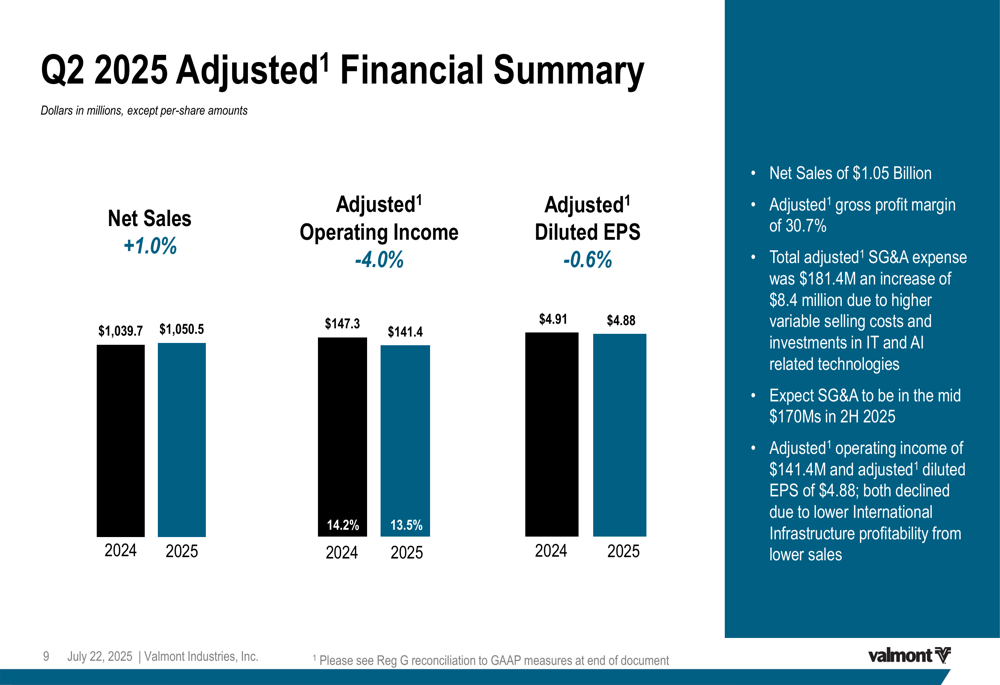
The company incurred approximately $138.3 million in non-recurring charges related to organizational realignment and portfolio refinements, with the majority ($105.5 million) associated with exiting the North American solar market and downsizing solar operations in Brazil. These strategic moves are expected to generate $22 million in annualized savings by 2026, with $8 million realized in the second half of 2025.
Segment Performance Analysis
Valmont’s Infrastructure segment, which accounts for approximately 73% of total sales, reported revenue of $765.5 million, a modest 0.4% increase year-over-year. However, adjusted operating income declined 6.7% to $124.6 million, primarily due to lower international profitability.
Within Infrastructure, performance varied significantly by business line. Telecommunications showed exceptional growth with sales increasing 40.5%, while Utility sales grew 5.4%. Conversely, Solar sales plummeted 47.4%, and Lighting and Transportation declined 6.9%.
The segment breakdown is illustrated here:
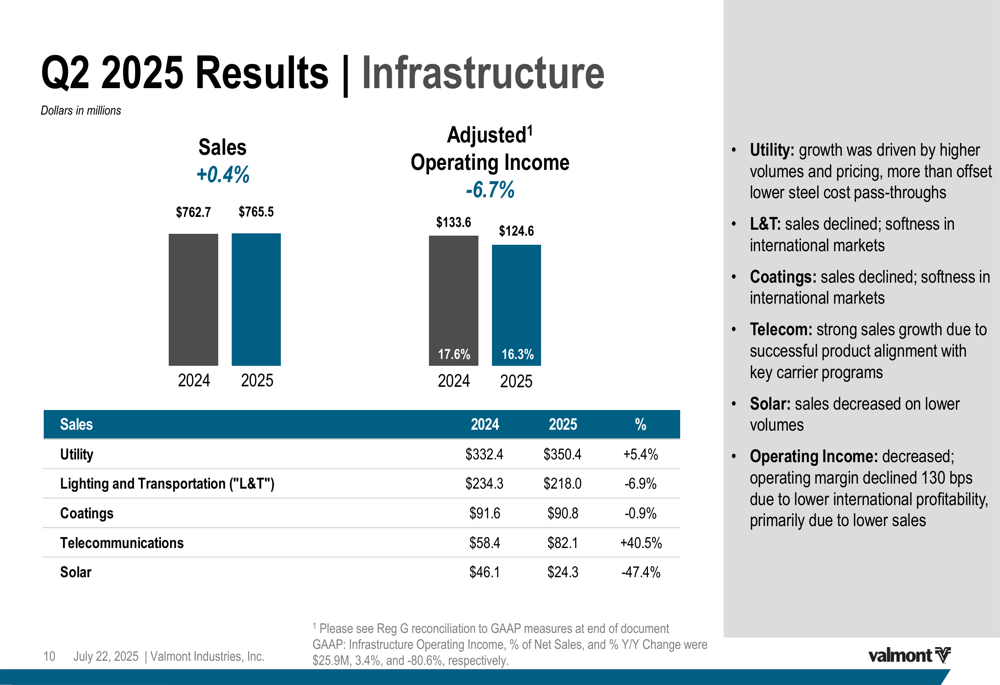
The Agriculture segment demonstrated resilience with sales of $289.4 million, up 2.7% year-over-year, and adjusted operating income increasing 12.2% to $44.8 million. This improvement was driven by strong international performance, where sales surged 22.0%, offsetting an 11.7% decline in North America.
The Agriculture segment results are detailed in the following chart:
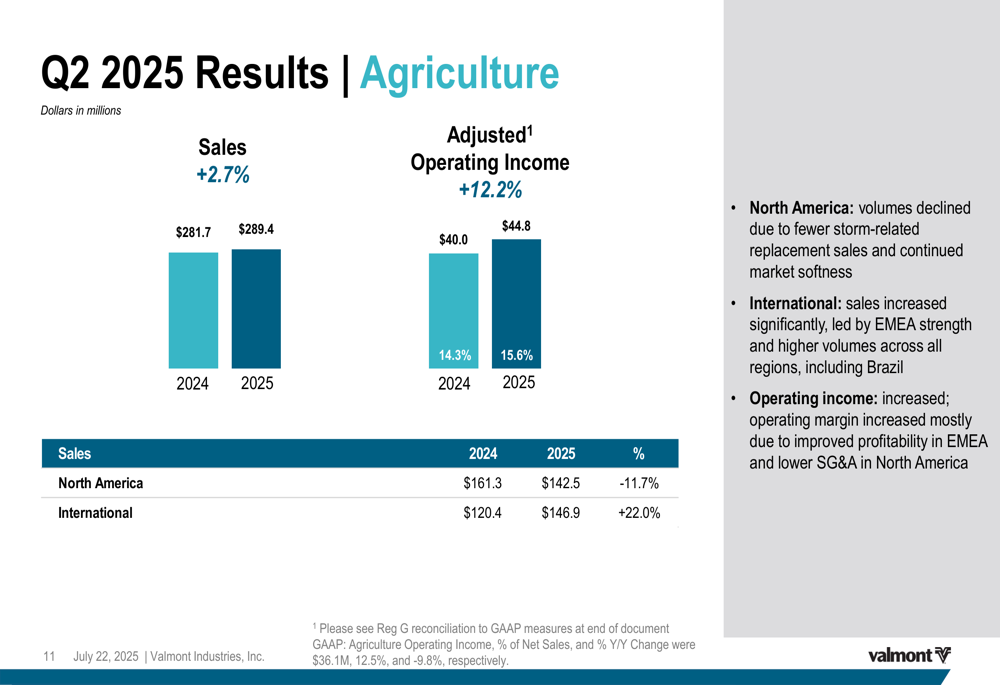
Strategic Realignment and Portfolio Refinements
A central theme of Valmont’s Q2 presentation was the significant organizational realignment and portfolio refinement initiatives. The company is exiting the North American solar market and downsizing solar operations in Brazil, while also assessing its APAC Access Systems business.
These strategic moves resulted in substantial one-time charges but position the company for improved long-term profitability. The realignment includes headcount reductions in Solar and North American Agriculture, shifting resources to growth opportunities, reducing management layers, and integrating operations.
The following slide details the realignment initiatives and their financial impact:
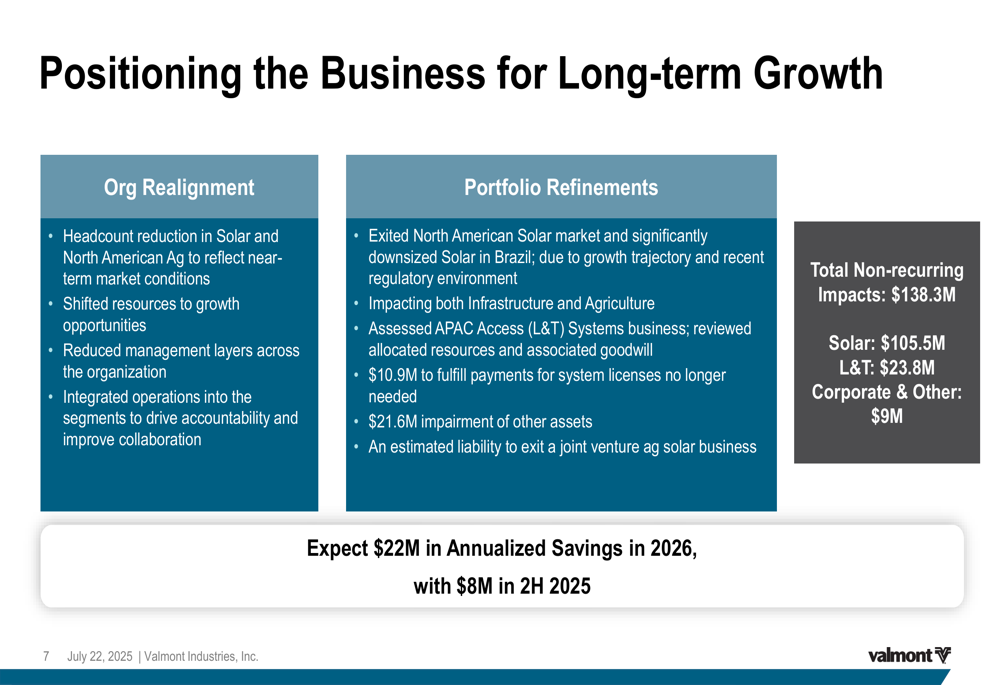
President and CEO Avner Applbaum emphasized that these changes are designed to refine the portfolio and streamline the organization, positioning Valmont for scale, execution, and long-term value creation. The company remains focused on accelerating growth, driving efficiency, and advancing innovation in its core markets.
Revised Outlook and Long-term Strategy
Despite the restructuring charges and mixed segment performance, Valmont raised its full-year 2025 adjusted diluted EPS guidance to $17.50-$19.50, up from the previous range of $17.20-$18.80. The company maintained its net sales outlook of $4.0-$4.2 billion.
The updated guidance reflects confidence in the company’s core markets, which align with megatrends in energy transition, infrastructure, and global food security. The guidance assumes the company will remain profit-neutral regarding tariffs, with mitigation plans in place.
The revised outlook is presented here:

Looking beyond 2025, Valmont outlined a long-term strategy focused on three key value drivers: capitalizing on infrastructure opportunities, positioning agriculture for growth, and maintaining disciplined resource allocation. The company projects these initiatives could add $500-700 million in revenue and $7-12 in EPS, with potential for $25-30 EPS in three to four years.
The company’s strategic roadmap is illustrated in this slide:
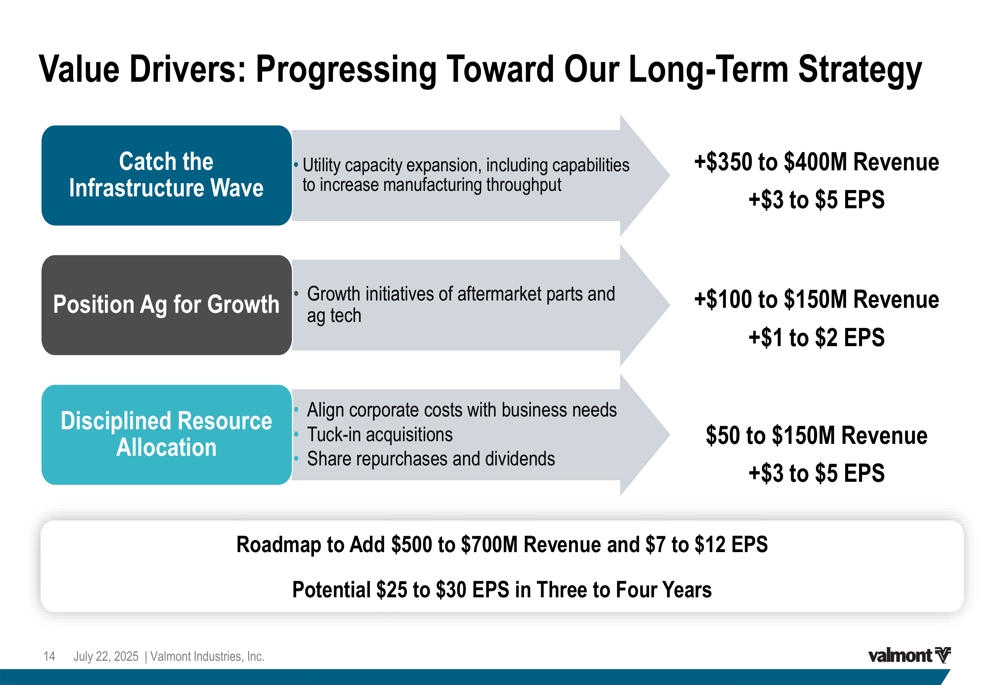
Capital Allocation and Financial Position
Valmont maintained a balanced approach to capital allocation in Q2 2025, with approximately 50% directed toward growing the business and 50% returned to shareholders. The company invested $32 million in capital expenditures during the quarter while returning $13.6 million to shareholders through dividends.
Share repurchases were particularly robust, with the company buying back $100 million of shares at an average price of $279.35 per share. This represents a significant acceleration from previous quarters and reflects management’s confidence in the company’s valuation and future prospects.
The company’s financial position remains strong, with a net debt to adjusted EBITDA ratio of approximately 1.0x, providing ample flexibility for future investments and shareholder returns.
As shown in the capital allocation priorities slide:

CFO Tom Liguori noted during the presentation that the company expects SG&A expenses to decrease to the mid-$170 million range in the second half of 2025, down from $181.4 million in Q2 on an adjusted basis. This reduction, combined with the anticipated savings from the organizational realignment, should support margin improvement in the coming quarters.
With its strategic realignment initiatives, balanced capital allocation approach, and focus on high-growth markets like utilities and telecommunications, Valmont appears well-positioned to navigate near-term challenges while building a foundation for long-term growth and value creation.
Full presentation:
This article was generated with the support of AI and reviewed by an editor. For more information see our T&C.
